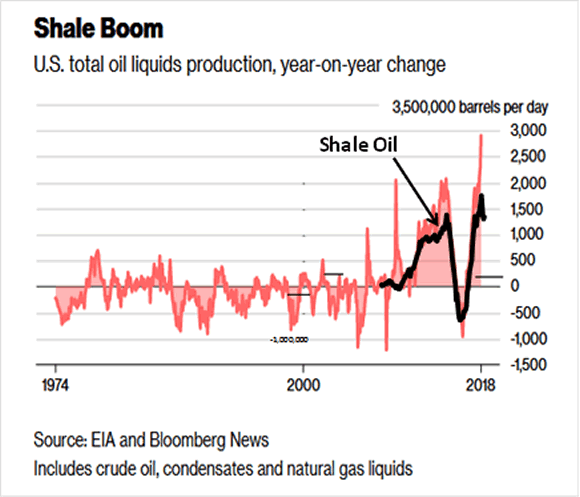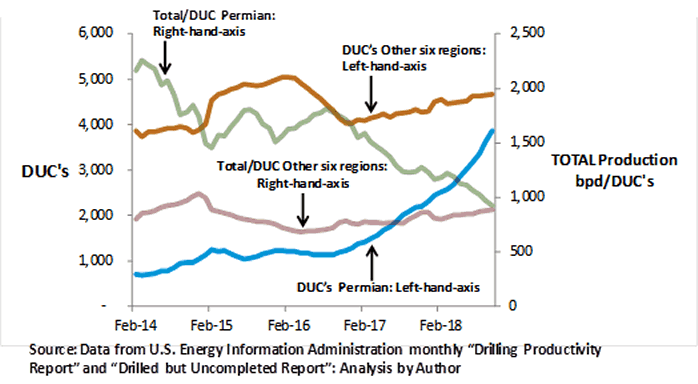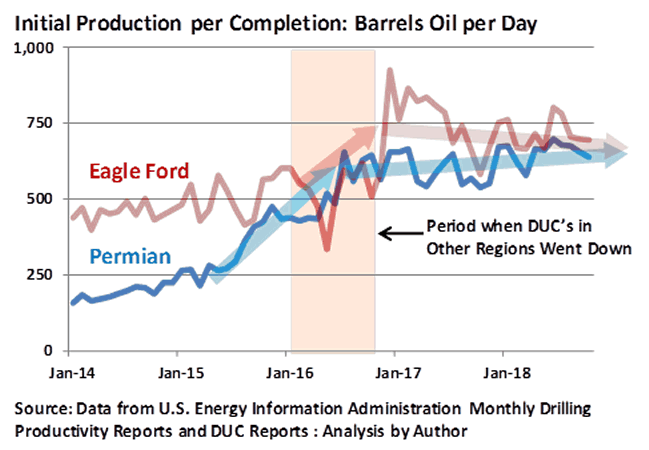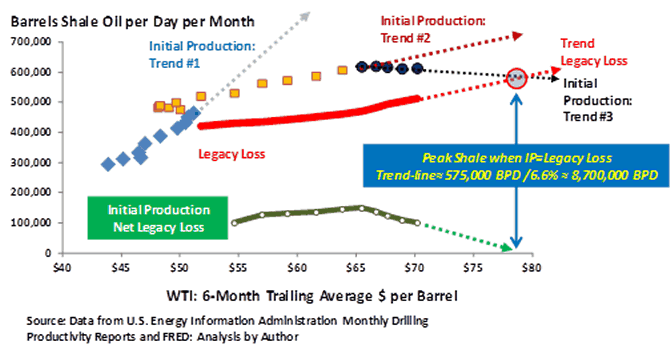What the Oil Short-sellers and OPEC Don't Know about Peak Shale / Commodities / Crude Oil
 A Black Swan is whensomething dramatic happens that most people did not expect, like when houseprices went down, not up...remember that?
A Black Swan is whensomething dramatic happens that most people did not expect, like when houseprices went down, not up...remember that?
Last week on Bloomberg News,Javier Blas wrote of a new “Shale Boom” that could...create “OPEC’sWorst Nightmare”. https://www.bloomberg.com/news/articles/2018-11-21/opec-s-worst-nightmare-the-permian-is-about-to-pump-a-lot-more
That sentiment reflects abroad consensus of opinion that has driven oil prices down 30% in two months.The central theme of the article was that the spike in year-on-year change ofU.S. production of “oil, condensate, andnatural gas liquids”, to 3.0 million barrels per day (MBPD) in August 2018,was proof of shale-oil’s continuing resurgence.
And the price of bananas isup this month too. That’s obviously proof; the year-on-year change in U.S. shaleoil production was 1.78 MBPD in August 2018, this month its 1.32 MBPD. That’sdown (20%), not up.
A large part of the rest ofthat was non-shale crude oil; 400,000 BPD new offshore-production coming on-linefrom, zero the month before. That extra-production was sanctioned before the2014 bust; which illustrates how long it can take from the final decision for anon-shale-oil venture, until the oil starts to flow. In any case, one spike isnot a trend; last month that was down to 300,000 BPD.
This is the chart put up byJavier Blas, with shale-oil superimposed:

However you look at it,change in shale-oil production has been trending down for the past six months.That’s not a sign of a boom set to explode, rather the opposite.
Perhaps the confusion wasbecause the Energy Information Administration (EIA), which reports all thosenumbers, issues multiple, and in some cases, overlapping-reports, so now-andthen commentators can confuse apples with banana’s, or condensate with crude.Also EIA doesn’t add-up all the numbers; so to make useful comparisons,sometimes it’s necessary to do a little simple arithmetic.
This is a chart of the morerecent history:

The black line is the oneline in the preceding chart, divided by 12-months for comparison with othermonthly estimates. The blue line is total initial production (IP), calculatedby multiplying IP-per-rig in each region by numbers of rigs, adding that up andthen subtracting total legacy loss. That’s a measure of the capacity, and theenthusiasm of operators to drill.
OK; the down-trend could bea blip, eyeballing trends is a mug’s game; but right now the trend is not up,it’s down; in other words the conclusion of “Shale-Boom round the corner”, mighthave been incorrect? Perhaps that tag-line should be re-worded to say “BlackSwan on the Horizon”?
“Black-Swan” because ifshale doesn’t deliver what almost everyone is projecting, and conventional E&P,which is still in the doldrums, cannot deliver enough to plug that gap, whichis what the CEO of Schlumberger and the Director of IEA, recently warned mighthappen, the price of oil could spike.
Granted, there are plausiblereasons for why the trend in growth-rate of shale-oil production has been goingdown, not up, some of which are presented by Javier Blas. His overriding thesisis that now, the pipelines serving Permian, are maxed-out, new pipelines arebeing built, once those come on line, there will be a boom.
That makes some sort of sense,but there are other ways to transport oil out of Permian, the reason operatorsprefer pipelines is because they are cheaper. Year-on-year, up to last month,oil prices went up by 45%, that ought to have covered the increased cost ofshipping, if that was really what was holding shale back.
Blas also reports that hewas told by “informed sources”; that in Permian, operators are drilling wellsbut not completing them, waiting for a good moment to do that, as in wheneither the oil-price goes up, or the pipelines come on-stream.
That’s another crediblestory; day-rates of drilling rigs, are going-up fast; so that could make sense,locking in low-cost before they go up more. But there-again, Blas’s sources...oil-men; areknown to be economical with the truth, from time to time; and they areperennial optimists; bless-them.
Drilled but Uncompleted(DUC) wells in Permian went from just 1,000 in 2014 to 4,000; over the past twoyears; on average, 35% of drilled wells in Permian ended up as DUC’s, soclearly there could be some truth in that story.
But some snide-commentatorshave suggested that many DUC’s are in fact, Dead-On-Arrival’s (DOA’s). You onlyget to know for sure what is the geology of the hole you drilled, after you drilledit, so a common reason to decide not to pump the sand and buy the pads; whichare the expensive parts of the operation; might be that what you got was lessthan optimal.
This chart can perhapsexplain what’s going on:

Yes DUC’s in Permian shotup, but that’s not a recent development, it started long-before there was talkof pipelines maxing-out. In early 2016,DUC’s in other regions fell, that was completions catching up, but only about20% of the “inventory” was completed, and Initial Production per completion(shown below), fell by 40%, indicating that those DUC’s were less than optimal.Perhaps the remaining 80% were DOA’s?
In 2014 there were 4,000holes in the ground in the six non-Permian regions, out of those, over the pastfour years likely none have been completed. Sure a DUC looks great on thebalance-sheet, “oil in the bank.”; if you got your auditor in your pocket. Oil-menhate to write-off stuff, I know a guy who bought twenty air-operated winches for$200,000 in 1998, great buy, never been rented, he thinks they are worth$500,000, perhaps in twenty years, as museum items; perhaps they may exhibitthose 4,000 DUC’s as part of the show. No doubt, in twenty-year’s time, therewill be a huge demand to see the 4,000 holes drilled in West Texas. Meanwhile,hardly anyone made any money in U.S. shale, leaving aside the bravado, thereare signs that “there’s a hole in daddy’sarm, where all the money goes”
https://www.youtube.com/watch?v=xSeBEgFjGLA
In 2014 Permian productionaccounted for 35% of total U.S. Shale production, now it’s 47%. Perhaps theincreased production was thanks to dirt-cheap day rates on drilling rigs,meaning that it was acceptable to risk more DOA’s?
Total production per DUC hasfallen dramatically in Permian, down to the level found in the other regions,perhaps all that’s happening is a normalization, and that when the “rainy-day”comes, less than 20% of Permian DUC’s will get completed?
Another indicator worthkeeping an eye on; is initial production per completion; the main reason no onetracks those numbers is EIA don’t report them, so you need to do arithmetic towork them out.

Another story that has beenmaking the rounds is the one about how the resurgence of shale-oil was thanksto can-do ingenuity and technology. The evidence does not support that thesis,although that’s not common knowledge because to see that number you need towork out IP from the DPR, then you need to get the other report EIA puts out,confusingly called the “Drilled but Uncompleted Report”, which enigmaticallycontains information on completions, which is not something you might not have guessed,from the title. No wonder everyone is confused about what’s going up and what’sgoing down.
Yes indeed, IP/C went updramatically in Permian after oil prices tanked, until two years ago. Thatmarker went down in Eagle ford, during the time 20% of the “rainy-day” DUC’s werecompleted, then when they got back into gear, drilling and completing, thatspiked, but the trend now, is down, not up.
Perhaps, in fact, the“magic” was nothing to do with technology, after all hydraulic-fracturing hasbeen around for years, long before anyone thought of using it for shale? In2016 hardly-used drilling rigs; and power-packs to pump the sand could bebought from liquidators for pennies; the cost of sand went from $87/ton to $25;and guess what, there is a straight-line correlation between how much sand youpump, and initial production (within limits). So everyone started drillinglonger laterals, so they could pump more cheap sand.
But today sand costs$75/ton; CAT jacked prices on the power-packs, steel for the casing and thepads costs double what it was in 2016, oil-service companies are starting topick up business offshore, so their prices went up, and the best drillers andgeologists are trading views of Permian farm-land, for all-round sea-views andlayovers in Phuket.
Here’s a thought, perhapsthe reason why, since the re-boot in September 2016, shale oil production wentup by 2.4 MBPD, which is much more than OPEC took off the table, was simplythat costs went down. If so, now that costs have gone up, and are set to go upmore, logically that should mean new-production is set to go...down, not up?
This is a plot of totalinitial production, net-legacy; against the six-month trailing oil price.

The X-axis is the six-monthtrailing average of WTI, which is kind-of a proxy for time, these-days. Theidea for using that is because shale-drillers look at where the price seems tobe going, decide how much to hedge, then go for it. Shale is many short-termplays, if you don’t make your money-back on a play in eighteen months, well;you need to put on your best suit, polish your cowboy boots, and go findanother sucker on Wall Street.
Trend#1: Low oil price, OPEC thought they had shale on the run, if they kept pumping shale would die. ExceptE&P worldwide ground to a halt, costs went towards zero, and pesky shalecame back, with a vengeance.
Trend#2: Yes oil prices were up, but costs went up faster.
Trend#3: That’s logical...to a Black Swan; oil prices going up and shale InitialProduction goes down.
Last but not least, is thetrend in legacy-loss, right now shale needs to find 500,000 bpd new oil everymonth, just to stay-even; that number is going up; when it equals IP, that’sPeak Shale.
Intriguingly, when OPEC cutback, oil prices went up, and that hastened the demise of shale, because costswent up more than prices. That’s a negative feedback loop, (1) oil price goesup; (2) everyone starts to drill, (3) cost of drilling goes up so no-one makesany money; (4) everyone stops drilling, (5) price of oil goes up...round andround.
The reason oil pricescrashed to under $30 Brent, not $64, which is where anyone who predicted thebust, more than two years in advance, said it would go; was because for twoyears OPEC, uncharacteristically, decided to pump more, not less.
They deny that was astrategy to kill-off shale oil. In any case if that was the strategy it didn’twork, because the whole of the oil industry all over the world imploded; soanyone with any sense could buy bank-owned equipment for pennies.
Then, because costs werethrough the floor, shale boomed. Thank you very much Mr. OPEC.
The best-thing OPEC can donext week; would be to cut production, and then wait, for a year or so, forshale oil to wither and die. Whether or not that will leave enough time forconventional E&P to plug the gap, is anyone’s guess.
The model that, in 2011,predicted the oil price would plunge to $64, is saying it won’t, and likelywithin a few years we could be looking at $150 Brent. That’s up, not down.
By Andrew Butter
Twenty years doing market analysis and valuations for investors in the Middle East, USA, and Europe. Ex-Toxic-Asset assembly-line worker; lives in Dubai.
© 2018 Copyright Andrew Butter- All Rights Reserved
Disclaimer: The above is a matter of opinion provided for general information purposes only and is not intended as investment advice. Information and analysis above are derived from sources and utilising methods believed to be reliable, but we cannot accept responsibility for any losses you may incur as a result of this analysis. Individuals should consult with their personal financial advisors.
Andrew Butter Archive |
© 2005-2018 http://www.MarketOracle.co.uk - The Market Oracle is a FREE Daily Financial Markets Analysis & Forecasting online publication.
